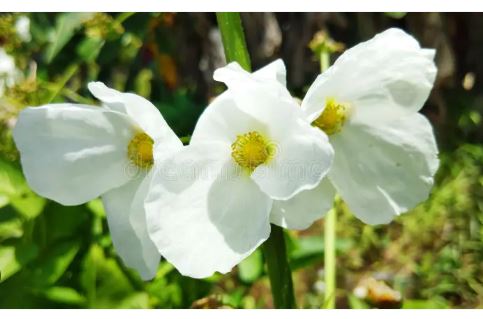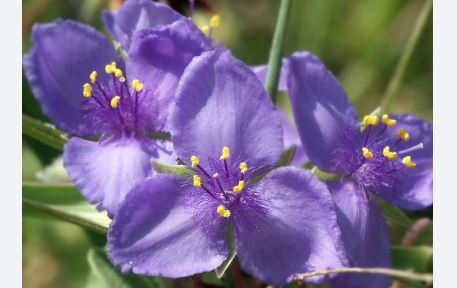
Flowers with three petals, often found in monocotyledonous plants, showcase a trimerous structure where floral parts typically occur in threes. These blooms may have three true petals or three petal-like sepals (tepals), creating a symmetrical, often star- or cup-shaped appearance. Common in families like Iridaceae and Liliaceae, they range from vibrant to delicate hues, thriving in diverse habitats from woodlands to arid regions. Their simplicity and elegance make them favorites in gardens and natural landscapes.
These flowers attract pollinators like bees, butterflies, and hummingbirds with their open, accessible shapes and nectar-rich centers. Some bloom in spring, signaling seasonal shifts, while others appear in summer or fall, adding bursts of color. Many grow from bulbs or corms, suited for well-drained soil and varying light conditions, from full sun to partial shade. Their adaptability makes them ideal for borders, rock gardens, or naturalized lawns.
Cultivation is straightforward for most three-petaled flowers, though some require specific conditions like moist, humus-rich soil or dry, sandy environments. Hardiness spans USDA zones 2–11, depending on the species, with some naturalizing easily and others needing protection from frost or excessive moisture. Regular care, such as dividing bulbs or removing spent blooms, ensures vibrant displays, though some can become invasive if unchecked.
Ecologically, these flowers support biodiversity by providing nectar and habitat for pollinators. Some have cultural or culinary significance, with parts used in traditional remedies or as spices. Their understated beauty, often paired with intricate markings or textures, captivates gardeners and foragers alike, offering both aesthetic appeal and functional roles in ecosystems.

Flowers With Three Petals
Iris (Iris spp.)
Iris flowers, known for their elegant, three-petaled structure, feature three upright petals (standards) and three downward-curving sepals (falls), often in vibrant shades of purple, blue, yellow, or white. Native to temperate regions, they thrive in full sun to partial shade and well-drained soil (USDA zones 3–9). The falls may have intricate veining or beards, attracting pollinators like bees. Irises are prized for ornamental gardens, with their striking blooms appearing in spring or summer.
Trillium (Trillium spp.)
Trillium, or wake-robin, produces delicate, three-petaled flowers in white, pink, red, or yellow, set above a whorl of three leaves. Native to North America and Asia, they prefer shady, moist, humus-rich soil in woodlands (zones 4–8). Blooming in spring, these perennials attract ants for seed dispersal. Trilliums are valued in native plant gardens but grow slowly, requiring protection from disturbance due to their rhizomatous nature.
Daylily (Hemerocallis spp.)
Daylilies feature trumpet-shaped flowers with three petals and three sepals (collectively called tepals), in colors like orange, yellow, red, or pink. Native to Asia, they thrive in full sun to partial shade and adaptable soils (zones 3–9). Each bloom lasts a day, but multiple buds ensure a long season. Daylilies are low-maintenance, used in borders or mass plantings, and some varieties are edible, attracting pollinators like butterflies.
Snowdrop (Galanthus nivalis)
Snowdrops bear dainty, bell-shaped flowers with three elongated outer petals (tepals) and three smaller inner ones, typically white with green markings. Native to Europe, they bloom in late winter or early spring, preferring partial shade and moist, well-drained soil (zones 3–7). Their nodding flowers signal spring’s arrival, making them popular in woodland gardens, where they naturalize and attract early pollinators.
Crocus (Crocus spp.)
Crocus flowers have three petals and three sepals, forming a cup-shaped bloom in purple, white, yellow, or blue, often with delicate veining. Native to Mediterranean regions, they thrive in full sun and well-drained soil (zones 3–8), blooming in early spring or fall, depending on the species. Crocuses are ideal for rock gardens or lawns, attracting bees, and their stigmas (from C. sativus) yield saffron.
Tulip (Tulipa spp.)
Tulips produce iconic, cup-shaped flowers with three petals and three sepals, indistinguishable as tepals, in nearly every color, including red, yellow, white, and bi-tones. Native to Central Asia, they grow in full sun and well-drained soil (zones 3–8), blooming in spring. Planted as bulbs, tulips are staples in formal gardens or containers, attracting pollinators, though many hybrids require annual replanting for best performance.
Fritillary (Fritillaria spp.)
Fritillary flowers, often bell-shaped, feature three petals and three sepals in colors like purple, yellow, or white, sometimes with checkered patterns, as in F. meleagris (snake’s head fritillary). Native to Europe and Asia, they prefer full sun to partial shade and well-drained soil (zones 4–8), blooming in spring. These bulbs are used in woodland or rock gardens, attracting bees, but some species have a musky scent.
Spider Lily (Lycoris spp.)
Spider lilies, like Lycoris radiata, have striking, three-petaled, three-sepaled flowers with long, curling stamens, resembling spiders, in red, white, or pink. Native to East Asia, they thrive in partial shade and well-drained soil (zones 6–9), blooming in late summer or fall. Their bulbs produce flowers before leaves, making them dramatic in borders or containers, attracting pollinators like butterflies.
Amaryllis (Amaryllis belladonna)
Amaryllis, or belladonna lily, bears large, trumpet-shaped flowers with three petals and three sepals in pink, white, or red, atop leafless stems. Native to South Africa, it grows in full sun and well-drained soil (zones 7–10), blooming in late summer. Planted as bulbs, amaryllis is stunning in Mediterranean gardens, attracting bees and hummingbirds, with its fragrant flowers lasting weeks.
Narcissus (Narcissus spp.)
Narcissus, including daffodils, features flowers with three petals and three sepals surrounding a central trumpet or cup, in white, yellow, or bicolor combinations. Native to Europe and North Africa, they thrive in full sun to partial shade and well-drained soil (zones 3–8), blooming in spring. These bulbs naturalize in lawns or borders, attracting early pollinators, though they’re toxic to pets.
Blue-Eyed Grass (Sisyrinchium angustifolium)
Blue-eyed grass produces small, star-shaped flowers with three petals and three sepals, typically blue with yellow centers, resembling tiny irises. Native to North America, it grows in full sun to partial shade and moist, well-drained soil (zones 4–18). Blooming in spring to summer, it’s ideal for native or meadow gardens, attracting bees, with its grass-like foliage adding texture year-round.
Mariposa Lily (Calochortus spp.)
Mariposa lilies have delicate, three-petaled flowers with three sepals, often white, yellow, or lilac, marked with intricate spots or stripes. Native to western North America, they prefer full sun and dry, well-drained soil (zones 5–9), blooming in spring or early summer. These bulbs suit rock gardens or native plantings, attracting pollinators like bees, but require minimal water once established.
Colchicum (Colchicum autumnale)
Colchicum, or autumn crocus, produces delicate, goblet-shaped flowers with three petals and three sepals, typically pink or lilac, emerging without leaves in fall. Native to Europe, it thrives in full sun to partial shade and well-drained soil (USDA zones 4–9). Blooming in autumn, these corms are ideal for rock gardens or borders, attracting bees, but all parts are toxic, requiring cautious handling around pets and children.
Zephyranthes (Zephyranthes spp.)
Zephyranthes, or rain lilies, bear star-shaped flowers with three petals and three sepals in white, pink, or yellow, often blooming after rain. Native to the Americas, they grow in full sun to partial shade and well-drained soil (zones 7–10). Flowering in summer or fall, these bulbs are perfect for borders or containers, attracting pollinators like butterflies, with their grass-like foliage persisting year-round.
Agapanthus (Agapanthus spp.)
Agapanthus, or African lily, features umbels of funnel-shaped flowers, each with three petals and three sepals, in blue, purple, or white. Native to South Africa, it thrives in full sun and well-drained soil (zones 8–11), blooming in summer. Grown as perennials or container plants, agapanthus attracts bees and hummingbirds, adding bold structure to borders, though it may need winter protection in cooler zones.
Hesperantha (Hesperantha coccinea)
Hesperantha, or crimson flag, produces vibrant, star-shaped flowers with three petals and three sepals, typically red or pink, on slender stems. Native to South Africa, it grows in full sun to partial shade and moist, well-drained soil (zones 7–9), blooming in late summer to fall. Ideal for wetland gardens or borders, it attracts pollinators and naturalizes easily, with grassy foliage adding texture.
Nerine (Nerine bowdenii)
Nerine bears clusters of lily-like flowers with three petals and three sepals, often pink or white with wavy edges, atop leafless stems. Native to South Africa, it thrives in full sun and well-drained soil (zones 8–10), flowering in fall. These bulbs are striking in rock gardens or containers, attracting bees, and their blooms last well as cut flowers, requiring minimal water once established.
Gladiolus (Gladiolus spp.)
Gladiolus produces tall spikes of funnel-shaped flowers, each with three petals and three sepals, in colors like red, pink, white, or yellow. Native to Africa and the Mediterranean, they grow in full sun and fertile, well-drained soil (zones 7–10), blooming in summer. Planted as corms, gladioli are popular in cutting gardens or borders, attracting hummingbirds, though staking may be needed for tall varieties.
Allium (Allium tricoccum)
Allium tricoccum, or wild leek, bears small, star-shaped flowers with three petals and three sepals, typically white, in umbels atop slender stems. Native to North America, it thrives in shady, moist, rich soil (zones 3–7), blooming in summer. This woodland perennial attracts bees and is valued for its edible leaves and bulbs, making it a favorite in native and foraging gardens.
Tigridia (Tigridia pavonia)
Tigridia, or tiger flower, features exotic, three-petaled flowers with three smaller sepals, in vibrant red, yellow, or white with spotted centers. Native to Central and South America, it grows in full sun and well-drained soil (zones 8–10), blooming in summer. Each flower lasts a day, but corms produce successive blooms, ideal for borders or containers, attracting pollinators like bees.
Belamcanda (Iris domestica)
Belamcanda, or blackberry lily, produces star-shaped, orange flowers with three petals and three sepals, often speckled with red, followed by seed pods resembling blackberries. Native to Asia, it thrives in full sun and well-drained soil (zones 5–9), blooming in summer. This perennial suits cottage gardens, attracting butterflies, with its sword-like leaves adding year-round structure.
Saffron Crocus (Crocus sativus)
Saffron crocus bears delicate, lilac-purple flowers with three petals and three sepals, notable for their vivid red stigmas used as saffron spice. Native to the Mediterranean, it grows in full sun and well-drained soil (zones 6–9), blooming in fall. Planted as corms, it’s ideal for culinary gardens, attracting bees, though harvesting stigmas is labor-intensive.
Scilla (Scilla siberica)
Scilla, or Siberian squill, produces small, bell-shaped flowers with three petals and three sepals, typically bright blue, on short stems. Native to Eurasia, it thrives in partial shade and moist, well-drained soil (zones 2–8), blooming in early spring. These bulbs naturalize in lawns or woodland gardens, attracting early pollinators, with their grass-like foliage fading after flowering.
Ornithogalum (Ornithogalum umbellatum)
Ornithogalum, or star-of-Bethlehem, bears star-shaped, white flowers with three petals and three sepals, often with green stripes on the outer surfaces. Native to Europe and Africa, it grows in full sun to partial shade and well-drained soil (zones 4–9), blooming in spring. These bulbs are used in borders or rock gardens, attracting bees, but can be invasive, requiring careful management.